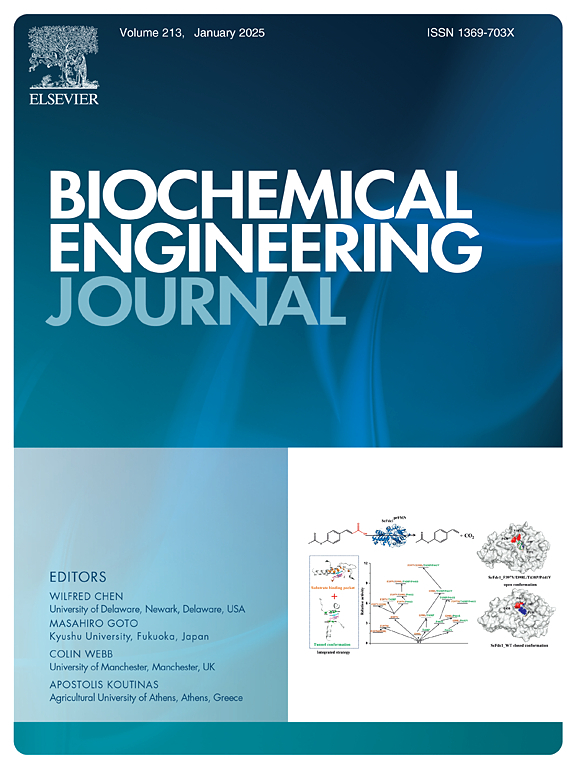利用水热法活化的菠萝皮生物炭去除废水中重金属的铅 (II) 吸附机理探析
IF 3.7
3区 生物学
Q2 BIOTECHNOLOGY & APPLIED MICROBIOLOGY
引用次数: 0
摘要
了解吸附机理对设计和运行基于吸附的废水处理系统具有重要作用。本研究利用理论吸附模型和 FT-IR、TG-DSC 和 SEM-EDX 等前沿分析技术,系统地论证了水溶液中铅(II)离子在由柚子皮合成的生物炭上的综合吸附机理。结果表明,在优化条件下,吸附过程遵循 Redlich-Peterson 等温模型和颗粒内扩散动力学模型。有效吸附铅(II)的关键机制包括络合、离子交换和内扩散。此外,水热法提高了活性生物炭的表面积,从而使柚子皮衍生生物炭的最大铅(II)吸附容量达到 83.86 mg/g,高于以往研究中柚子废物其他部分(种子和茎)的生物炭以及来自不同农业残留物的一些材料。这些发现有助于缩小对生物质残渣重金属吸附、理论模型及其机理的认识差距。此外,这些研究还表明,柚子皮等农副产品是实施旨在减轻废水中重金属污染的策略的环保而经济的材料。本文章由计算机程序翻译,如有差异,请以英文原文为准。
Insights into Pb (II) adsorption mechanisms using jackfruit peel biochar activated by a hydrothermal method toward heavy metal removal from wastewater
Understanding adsorption mechanisms plays an instrumental role in designing and operating adsorption-based wastewater treatment systems. This research systematically demonstrated the comprehensive adsorption mechanism of Pb(II) ions onto biochar synthesized from jackfruit peel in an aqueous solution using theoretical adsorption models and cutting-edge analytical techniques, such as FT-IR, TG-DSC, and SEM-EDX. The results showed that the adsorption process followed the Redlich-Peterson isothermal model and the intraparticle diffusion kinetic model under optimized conditions. The key mechanisms contributing to effective Pb(II) adsorption include complexation, ion - exchange, and intradiffusion. Furthermore, using the hydrothermal method to active biochar improves the surface area of JPT, leading to the maximum Pb(II) adsorption capacity of jackfruit peel-derived biochar to be 83.86 mg/g, higher than biochars from other parts of jackfruit waste (seeds and stems) and some materials from different agricultural residues in previous studies. These findings contribute to narrowing the gap in understanding heavy metal adsorption using biomass residues, theoretical models, and their mechanisms. Additionally, these indicate that agricultural by-products such as jackfruit peel are environmentally friendly and economical materials for implementing strategies aimed at mitigating heavy metal pollution in wastewater.
求助全文
通过发布文献求助,成功后即可免费获取论文全文。
去求助
来源期刊

Biochemical Engineering Journal
工程技术-工程:化工
CiteScore
7.10
自引率
5.10%
发文量
380
审稿时长
34 days
期刊介绍:
The Biochemical Engineering Journal aims to promote progress in the crucial chemical engineering aspects of the development of biological processes associated with everything from raw materials preparation to product recovery relevant to industries as diverse as medical/healthcare, industrial biotechnology, and environmental biotechnology.
The Journal welcomes full length original research papers, short communications, and review papers* in the following research fields:
Biocatalysis (enzyme or microbial) and biotransformations, including immobilized biocatalyst preparation and kinetics
Biosensors and Biodevices including biofabrication and novel fuel cell development
Bioseparations including scale-up and protein refolding/renaturation
Environmental Bioengineering including bioconversion, bioremediation, and microbial fuel cells
Bioreactor Systems including characterization, optimization and scale-up
Bioresources and Biorefinery Engineering including biomass conversion, biofuels, bioenergy, and optimization
Industrial Biotechnology including specialty chemicals, platform chemicals and neutraceuticals
Biomaterials and Tissue Engineering including bioartificial organs, cell encapsulation, and controlled release
Cell Culture Engineering (plant, animal or insect cells) including viral vectors, monoclonal antibodies, recombinant proteins, vaccines, and secondary metabolites
Cell Therapies and Stem Cells including pluripotent, mesenchymal and hematopoietic stem cells; immunotherapies; tissue-specific differentiation; and cryopreservation
Metabolic Engineering, Systems and Synthetic Biology including OMICS, bioinformatics, in silico biology, and metabolic flux analysis
Protein Engineering including enzyme engineering and directed evolution.
 求助内容:
求助内容: 应助结果提醒方式:
应助结果提醒方式:


